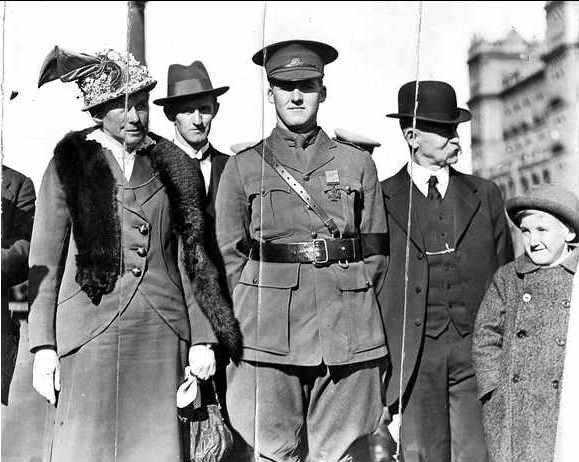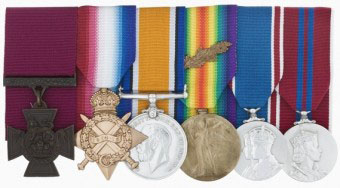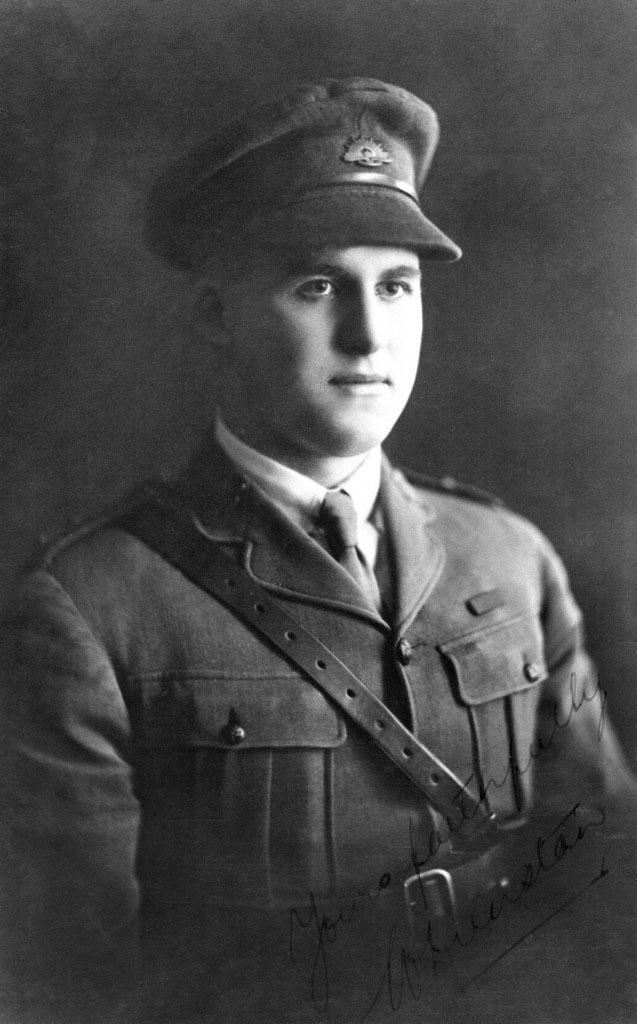William Dunstan was born in Ballarat East, Victoria. His father, William John Dunstan, a boot maker and his mother, Henrietta (nee’ Mitchell) welcomed their third son on March 8, 1895. They were a life-long Methodist and tee-totaling family with a strict adherence to Sunday service. With his two elder brothers and one older sister, William attended Golden Point State School in Ballarat. He began his working life after leaving school at the age of 15. William continued to study in the evenings at home whilst working during the day. His first job was as a messenger boy at Snows, a local Ballarat drapery store.
The Australian Military Forces compulsory training scheme was introduced in 1911. At age 16 William became part of the uniformed senior cadets. William reached the cadet rank of captain in the Citizen’s Military Forces, receiving paid training for 16 days of the year. In July 1914 William was commissioned lieutenant in the 70th Infantry Battalion (Ballarat Regiment).
One month later the outbreak of the First World War began changing the ambitions of young men and the international outlook of Australia as over 400,000 of the country’s fittest enlisted to fight for the Empire. No one anticipated that over 60,000 of them would never return home and many more would repatriate with life changing injuries, physical and mental. Among those who would join up for overseas service was a young and eager William Dunstan who had progressed to being a member of the clerical staff at Snows. William learned of the declaration of the war while at the CMF Camp in Queenscliff with the 70th.
Six weeks after the first Australian troops landing at ANZAC Cove William Dunstan resigned his CMF commission and enlisted as a private in the Australian Imperial Force on 2 June 1915. With no more than two weeks preparation Dunstan was promoted acting sergeant with 6th Reinforcements of the 7th Battalion and embarked from Melbourne for Egypt on A62 HMAT Wandilla.
With the 7th Battalion, 2nd Brigade, 1st Division Dunstan was an acting corporal at Gallipoli from 5 August 1915. He could have had no expectation that in just 4 days time he would be involved in the action that would later see him become one of just 63 Australians awarded the Victoria Cross during the Great War.
On August 6, the 2nd, 3rd and 4th Battalions attacked the Turkish position at Lone Pine, with the 1st and 12th Battalions in support. The plateau was central to the whole ANZAC position. The attack got bogged down in the labyrinth of roofed Turkish trenches. The Australian troops started to dig their own saps across no-man’s land to access the Turkish trenches. But it became easier to go over the top of the parapet of their own trenches, run to the Turks and fire down into their trenches. This left the Australian troops open to well emplaced Turkish machine guns. In the maze of open and underground Turkish trenches many of the Australian troops started getting lost. Others were caught by the Turkish defenders who were concealed behind corners and at intersections in the labyrinth of well-established trenches. During the following days the Australians were constantly under counter attack from the enemy. The 7th Battalion was sent up to the plateau to relieve the 1st and 2nd on the afternoon of August 8.
In the very early hours of August 9 the Turkish defenders made a ferocious counter-attack on the centre of a trench that had been recently captured and held by the 7th Battalion’s Lieutenant Fred Tubb and ten other men at Lone Pine. In desperation two of the men were tasked with a last ditch attempt to catch and throw back bombs from the Turkish attackers, or to attempt to diminish the blast from the bombs by covering them with their fellow soldier’s overcoats. Tubb, Dunstan, Corporal Alexander Burton and the other six men kept their rifles aimed and firing at the attacking enemy over the parapet of the trench as the two soldiers attempting to catch the Turkish bombs were horrendously mutilated.
Simultaneous bomb explosions then killed or wounded a further five men. Corporal Wright was killed when a bomb hit him in the face and Corporal Webb, an orphan from Geelong, had both hands blown off. Lieutenant Tubb, with Dunstan and Burton, continued to hold the trench alone until all but a foot of the barricade was demolished by a larger, more violent explosion. As Tubb valiantly attempted to drive the Turks back, Dunstan and Burton struggled to rebuild the barricade. After repelling the enemy and rebuilding the barricade a further two times, a well lobbed bomb landed between Dunstan and Burton. The subsequent explosion killed Burton and left Dunstan with injuries including temporary blindness which lasted almost a full year. Tubb obtained help, but by now the Turks had given up the fight and did not attack again.
Dunstan had a few weeks in hospital in Egypt with shrapnel in his head and body. By September 1915 Dunstan was invalided back home to Australia on HMAT A38 Ulysses. Dunstan was discharged on 1 February 1916 and Mentioned in Dispatches by General Sir Ian Hamilton in March. Burton was awarded a posthumous VC. Tubb was awarded his VC in the field. He was killed at Passchendaele in 1917 in an action that could easily have earned him a second VC.
Upon his return to Ballarat, Snows presented Dunstan with 50 pounds. He declined an offer of more money from the residents of Ballarat saying that there were hundreds of other Australians less lucky than him that had earned equal praise.
On 10 June 1916 Dunstan was presented with the VC outside Parliament House, Melbourne, by Governor-General The Right Honourable Sir Ronald Craufurd Munro Ferguson, GCMG, DL. William stood upright and still in his uniform with polished leggings and boots. Crowds had gathered and waited for hours to see the hero who had only three months earlier turned 21. On the steps of parliament, and among the crowd, to meet William was Minister for Defence, George Pearce, Dame Nellie Melba with her son, George Armstrong, a regiment in full uniform, complete with rifles and regimental colours, a massed brass band, photographers and members of the public who used every possible vantage point including the roofs of cars. They were all wearing black armbands as Lord Kitchener had drowned when his ship was sunk by a German mine just four days earlier. Reports of the investiture described an outburst of public fervor and Dunstan, who found it all an ordeal, was described as “a reserved man disliking fuss”. As Dunstan stepped back into the ranks the massed bands played “See the Conquering Hero Comes”. The Age of 10 June, 1916 reported:
When the ceremony was over a determined rush was made at the young soldier, who was very much more nervous than he was when stopping the onset of the Turks at Lone Pine, and thereby saving a very dangerous situation. The men wanted to carry him shoulder high, and the women to kiss him. Four tall constables rescued him, however, and he was then driven to the Overseas Club, where he was entertained by the women’s branch.
He might have been brave enough to win a VC but he wasn’t brave enough for all this!

After a short convalescence, and despite his injuries, Dunstan rejoined the Citizen Forces as Lieutenant, area officer, Ballarat and as acting Major, 18th Infantry Brigade. During this time he was active in the pro-conscription movement attending public rallies to show his support. At the height of the fury over the conscription referendum, Dunstan was in civilian clothes travelling on a St Kilda Road tram when a lady handed him a white feather, the symbol for anyone who is a coward.
William Dunstan and Marjorie Lillian Stewart Carnell, daughter of the manager of Farmers Hams & Bacon, were married at Ballarat’s St. Paul’s Church of England on 9 November 1918.
In 1921 Dunstan transferred to the 6th Infantry Battalion in Melbourne. He held a position of private secretary to Sir Nicholas Lockyer, the acting Secretary of the Repatriation Department (now known as the Department of Veterans’ Affairs). He also took a job as an accountant on the staff of Sir Keith Murdoch’s Herald and Weekly Times. Dunstan was transferred to the unattached list in 1923 and five years later to the reserve of officers retiring as a Lieutenant in 1928
In 1934 Dunstan had progressed through the administration of the Herald group from chief accountant and company secretary to general manager. He was extremely well thought of by many including work colleagues, politicians, the judiciary, many in his industry and other businessmen from England and North America. By many accounts he was able to make a friend with anyone who met him. He was considered by his work colleagues to be a considerate manager with professional eagerness to do the job and do it the right way. Because of this he was granted a great deal of freedom in the way he worked to administer the Herald and its associated enterprises.
By the late 1930’s William and Marjorie Dunstan were parents to two sons and a daughter. At the outbreak of World War II Dunstan contacted General Blamey to secure a command, only to be rejected on medical grounds. However all three of their children, William (Bill), Keith and Helen followed in their father’s footsteps and enlisted to serve their country as he had. RAAF Flight Lieutenant Keith Dunstan would, after the war, join his father at the Herald as a foreign correspondent. Keith would publish more than 25 books and become one of Australia’s most prolific writers earning him an OAM. Bill spent six years in the army and saw a great deal of action. Helen Joined the WRANs. She kept the family tradition of keeping quiet up to the moment 65 years later when she received a medal for her involvement with secret code work. Her family never knew. Dunstan, however, did secure a “war time” job as joint manager of the Australian Newsprint Pool.
Whilst he was always being praised for his actions at Lone Pine he never discussed his time as a soldier in the family home and tried his hardest to avoid discussing the matter when out. For many years Marjorie would take his medals out of a box stored under the stairs to show them to the children, almost always without William’s knowledge. William was not just living with memories of Gallipoli that would not leave him; he also suffered severe headaches caused by shrapnel that had remained lodged in his head. On Anzac Day he marched and often led the march to the Shrine. Marjorie was always worried about this day as, whilst he wasn’t a big drinker, he was known to have a few on Anzac Day. His adult children never marched out of a combination of respect and the awkwardness that came with living under the shadow of their father.
The long term effects of William’s war injuries encouraged his resignation as general manager in 1953. He took up offers to become a director of the Herald and number of other newsprint, radio and textiles companies. In his part-time retirement he campaigned to help the fight against cancer and availed himself of his membership of many horse racing clubs as well as his membership of the Australian, Athenaeum, Metropolitan Golf, Royal Melbourne and Naval and Military clubs. William also held the position of Chairman of the Australian Newspaper Proprietors’ Association for 15 years.
On 2 March 1957 William Dunstan suddenly died of coronary vascular disease while he was returning from a race meeting at Caulfield racecourse. He was survived by Marjorie and their three adult children. Over 800 people attended his funeral service at Christ Church, South Yarra. Among the crowd were seven Victoria Cross recipients. William’s body was cremated and the ashes intered at Springvale Botanical Cemetery. Marjorie passed away in 1974.
In 1995 a Memorial to Dunstan was erected in Sturt St near Doveton St in Ballarat. On Anzac day 2008 an Aleppo Pine was planted overlooking the footy oval at Golden Point State School in Ballarat. Guests at the ceremony included William’s son Keith Dunstan, Nancy McCallum, William’s niece, Tom Jobling, RSL president, Brian Broadridd from Legacy as well as students (including visiting students from a Canadian school) and parents.
The “Dunstan VC Club” is at the Australian Army Base at Puckapunyal, Victoria. William’s Victoria Cross is no longer in a box under the stairs. It is displayed in the Australian War Memorial Hall of Valour along with his 1914-15 Star, British War Medal, Victory Medal with Oakleaf (Mentioned in Dispatches), George VI Coronation Medal and Elizabeth II Coronation Medal.

Less than 9 months in the AIF.
Less than a week in combat.
A lifetime of honour and achievement.
Lest we forget.
Contact Jason McGregor about this article.







